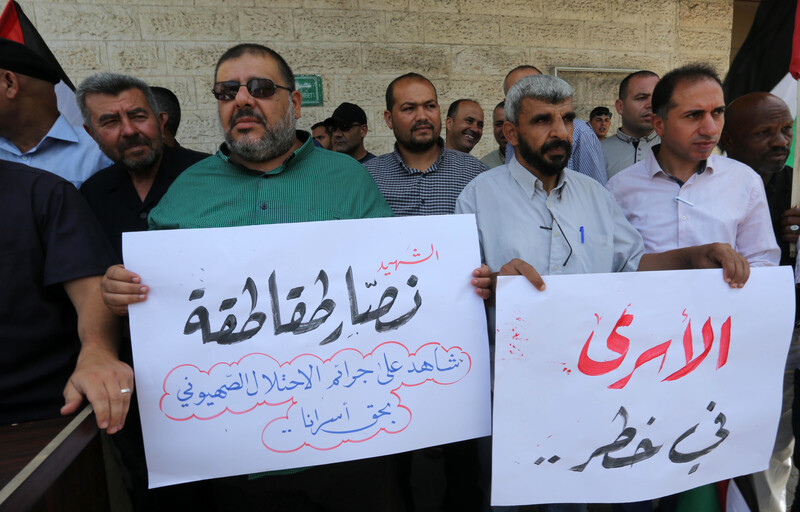Rights and Accountability 29 July 2019

Palestinians protest the death of Nassar Taqatqa in Israeli prisons, in front of the Red Cross building in Gaza City on 16 July.
APA imagesHuman rights organizations are holding Israel responsible for the death of detained Palestinian Nassar Taqatqa.
Taqatqa, 31, died on 16 July in Nitzan prison, less than a month into his detention.
Israeli forces arrested Taqatqa on 19 June from his home in the town of Beit Fajjar near the West Bank city of Bethlehem.
For the majority of his detention, he was held in the Russian Compound in Jerusalem, an Israeli detention center synonymous with the torture of Palestinian prisoners.
“There is serious concern that he was tortured and exposed to ill and/or degrading treatment while he was in detention,” the Palestinian Human Rights Organizations Council stated.
Israeli prison authorities then transferred Taqatqa to the al-Jalameh detention center in the northern West Bank and then finally to Nitzan prison inside Israel.
It is unclear what caused Taqatqa’s death, as Israel is refusing to release his body.
“Neither we nor his family have been communicated with or given access to his dead body,” the council added.
His family said that Taqatqa had no health problems prior to his imprisonment, according to the Palestinian Prisoners Club.
Among the council’s members are prisoners rights group Addameer, refugee advocacy group Badil, and human rights organizations Al-Haq, Al Mezan and Defense for Children International Palestine.
Bodies withheld
Since the beginning of 2018, three Palestinians have died in Israeli prisons, and others during arrest.
Palestinian prisoner Aziz Awisat died after Israeli officers severely beat him in Beersheba prison in May 2018.
Awisat, 53, allegedly poured hot water on a guard in the prison. He died days following the beating.
Palestinian prisoner Faris Baroud died after 28 years in Israeli detention in February.
Baroud, 51, spent the majority of his imprisonment in isolation and died after years of medical neglect.
The bodies of Taqatqa, Baroud and Awisat are still held by Israel.
Some 220 Palestinians have died in Israeli custody since 1967, according to Addameer.
This includes 23 Palestinians who died after they were tortured since Israel ratified the United Nations Convention against Torture in 1991, according to the statement.
Expelling photojournalist
Meanwhile, Jordan refused entry to photojournalist Mustafa al-Kharouf after Israel attempted to forcibly exile him last week.
Israel’s interior ministry insists that al-Kharouf has a Jordanian passport and that he can be expelled to Jordan whether or not he is a citizen of that country.
However al-Kharouf’s lawyer, Adi Lustigman, had told an Israeli court that his only travel document is a laissez-passer, and that a Jordanian diplomat had informed her that al-Kharouf would be denied entry, according to Israeli daily Haaretz.
Israeli forces arrested al-Kharouf in January and kept him in Givon prison in Ramle in present-day Israel where asylum-seekers and others facing expulsion are usually held.
In February, an Israeli court denied him family reunification citing “security grounds” and ordered him forcibly exiled to Jordan.
Al-Kharouf has not been charged or tried, and agents of Israel’s Shin Bet secret police and a Jerusalem court did not respond to Lustigman’s inquiry as to why that is, if he really posed a security threat.
The interior ministry also accused al-Kharouf of being a member of Hamas, a claim he denies.
Al-Kharouf was born in Algeria to a Palestinian father and an Algerian mother but he is not a citizen of any country, according to the Committee to Protect Journalists (CPJ).
His wife and child are both from East Jerusalem and have permanent residency status issued by Israeli occupation authorities, Haaretz reported.
He has been living in occupied East Jerusalem since he was 12 years old.
Assault on journalists
Israeli soldiers fired rubber-coated steel bullets and tear gas canisters at Palestinian journalists in the occupied West Bank and Gaza Strip earlier this month.
Three Palestinians were injured, according to CPJ.
Among them was photojournalist Ayat Arqawy, whose work has occasionally appeared on The Electronic Intifada.
Israeli soldiers fired a tear gas canister that hit Arqawy in the stomach while she was covering protests against Israel’s demolition of buildings earlier this month in the Wadi Hummus neighborhood on the outskirts of Sur Bahir, a village southeast of Jerusalem in the occupied West Bank.
Tags
- Nassar Taqatqa
- Nitzan-Magen prison
- Beit Fajjar
- Bethlehem
- Russian Compound
- Palestinian Human Rights Organizations Council
- Palestinian Prisoners Club
- Addameer
- Al Mezan Center for Human Rights
- Defense for Children International-Palestine
- Al-Haq
- Badil
- Aziz Awisat
- Faris Baroud
- Mustafa al-Kharouf
- Adi Lustigman
- Jordan
- Committee to Protect Journalists
- Ayat Arqawy
- Medical neglect
- Death of prisoners




